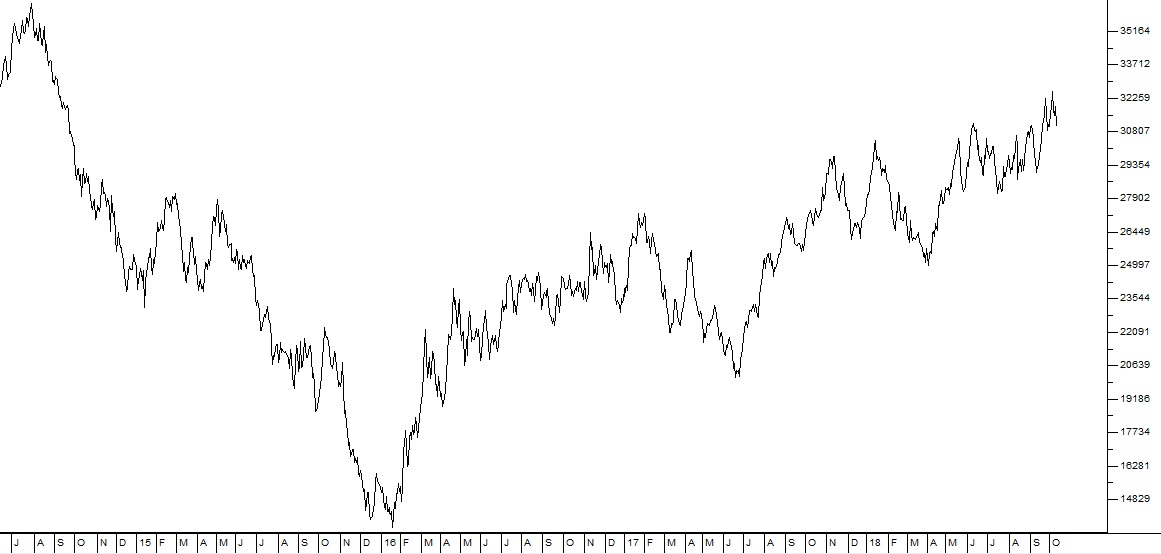Mining
It would be fair to say that the South African economy has been substantially built on mining – first diamonds, then gold and then platinum and a host of base metals and minerals.
South Africa is home to two geological features which have endowed it with enormous mineral wealth. They are the Witwatersrand Basin and the Bushveld Igneous Complex.
The Witwatersrand basin is an ancient sea bed which is buried under layers of sediment. It breaks the surface just south of Johannesburg and dips towards the south at an angle of about 20 degrees. As it goes deeper, the grades of gold increase because the weight of gold naturally caused it to sink deeper than other minerals. When extracted, the reef often includes the skeletons and shells of the ancient mollusks which once occupied that sea.
So gold mining began just south of Johannesburg, where the lip of the sea bed broke the surface, and then progressed towards the south, going deeper and deeper giving higher grades, but becoming progressively more expensive and difficult to mine. By the early 1930’s, it was generally thought that the gold mining industry in South Africa was reaching the end of its economically viable life, but then a new, far cheaper, method of extracting gold from the ore, known as “heap leaching” was invented. This technique gave mining a new lease on life and made it economically viable to mine ore at much greater depths. Today, once again, deep-level gold mining is reaching the end of its economic viability. However, South Africa still has more than 40% of the world’s known underground reserves of gold – but most of it is just too deep to mine economically with current technologies.
The Bushveld Igneous Complex is an extraordinary igneous intrusion, by far the largest of its kind in the world, where molten lava was forced up between layers of sedimentary rock where it cooled and solidified about 2 billion years ago. It has a surface area of 66 000 square kilometers and is shaped like a ragged four leaf clover with its stalk pointing towards Tshwane (Pretoria). It is one of the great treasure houses of the world which includes platinum group metals (PGMs), gold, chrome, copper, nickel, tin, iron, fluorspar and vanadium.
As ore bodies of precious metals became deeper and less viable, base metals and minerals have taken their place as the most profitable mining ventures in this country. Mining technology is always developing and improving, which means that precious metals might once again dominate South African mining at some time in the future.
Until the start of 2016, the mining sector was suffering from low commodity prices. But in January 2016, that cycle turned (following a “double bottom”) and the prices of metals and minerals began to rise. Since then, mining companies have been doing better. Consider the chart of the JSE Mining index:


JSE Mining Index June 2014 to October 2018 - Chart by ShareFriend Pro
Today the primary difficulty of mining is legislative. The industry is waiting for the final settlement of the third mining charter together with its “guidelines” – which will determine the viability and attractiveness of investing further into this industry. Hopefully, that will be settled by the end of 2018. The certainty of knowing exactly what the rules for mining are is likely to be a major boon. South Africa, which is currently regarded as very unattractive by the international mining houses of the world, could begin to claw its way back into their consideration. This will result in steadily increasing employment in the mining industry. From a private investor’s perspective, mining shares look attractive, but remain risky. One investment analyst has described buying mining shares as “buying a hole in the ground surrounded by a mass of angry workers” and that is not far from the truth. A mine is, by definition, a very expensive diminishing asset which is usually subject to intense union action. The best mines are the highly mechanized shallower operations – where union action is minimized and the cost of extracting the ore is much lower. As the world economy recovers steadily from the sub-prime crisis of 2008 we can expect the prices of commodities to continue to rise. This means that mining those metals and minerals will become increasingly profitable and represent a better and better investment opportunity. But investors need to do their homework and consider carefully the market for the minerals which they choose to patronize. And, of course, a strict stop-loss strategy is essential when investing in commodity shares.← Back to Articles